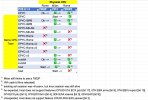Hello
We are running PVE 8.1.3 on HPE DL 325/365 Gen 10 servers with different CPUs.
Usually we only use 6 DL 325 with AMD EPYC Rome (7502P and 7502P).
A while ago we added a seventh server which has a Milan 7513 CPU (two sockets).
While doing live migrations for lifecycle (Patching) purpose we had some machines crashing. We found out that migration from Rome to Milan seems to be ok, but migration back from Milan to Rome made some of the machines unresponsive or even crash/reboot.
Usually we run vms with qemu cpu type «default», which means IMHO kvm64. For performance reasons (back in PVE 7) some of the vm had other cpu types.
So we went and did build test machines (2 vCPU, Alma Linux) and migrated them forth and back.
Sorry for using a picture to explain, it was easiest.
We wonder, why are there so many different EPYC cpu types. And especially, why Rome seems not to run on a Rome CPU. Nero seems to have burnt it down
Also, our performance test (sysbench) shows average performance on (mostly idle) hosts
- Best performance on a 7502P (Rome) with QEMU cpu type = EPYC IBPB (12% more events per second as with host (lowest))
- Best performance on a 7513 (Milan) with QEMU cpu type = EPYC (18% more events per second as with kvm64 (lowest))
We found different sites with different explanations or reasons and would like to know, what would be best.
Regards, Urs
We are running PVE 8.1.3 on HPE DL 325/365 Gen 10 servers with different CPUs.
Usually we only use 6 DL 325 with AMD EPYC Rome (7502P and 7502P).
A while ago we added a seventh server which has a Milan 7513 CPU (two sockets).
While doing live migrations for lifecycle (Patching) purpose we had some machines crashing. We found out that migration from Rome to Milan seems to be ok, but migration back from Milan to Rome made some of the machines unresponsive or even crash/reboot.
Usually we run vms with qemu cpu type «default», which means IMHO kvm64. For performance reasons (back in PVE 7) some of the vm had other cpu types.
So we went and did build test machines (2 vCPU, Alma Linux) and migrated them forth and back.
Sorry for using a picture to explain, it was easiest.
We wonder, why are there so many different EPYC cpu types. And especially, why Rome seems not to run on a Rome CPU. Nero seems to have burnt it down
Also, our performance test (sysbench) shows average performance on (mostly idle) hosts
- Best performance on a 7502P (Rome) with QEMU cpu type = EPYC IBPB (12% more events per second as with host (lowest))
- Best performance on a 7513 (Milan) with QEMU cpu type = EPYC (18% more events per second as with kvm64 (lowest))
We found different sites with different explanations or reasons and would like to know, what would be best.
Regards, Urs


